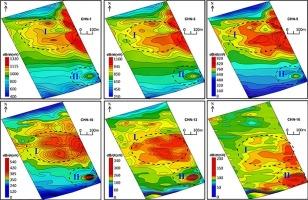Exploration with loop-source Semi-Airborne transient electromagnetic method (LSATEM) in the shallow coverage area of East Tianshan, Xinjiang, Northwest China
IF 3.6
2区 地球科学
Q1 GEOLOGY
引用次数: 0
Abstract
The East Tianshan region in Xinjiang harbors substantial mineralization potential in its shallowly covered areas. However, the Gobi desert terrain and the presence of shallow salt-alkali crusts pose significant challenges for conventional ground electromagnetic methods. In response, the loop-source semi-airborne transient electromagnetic method (LSATEM) offers a superior alternative. This advanced technique leverages a loop configuration for ground transmission and aerial reception, boasting advantages such as independence from grounding conditions, a substantial magnetic moment, and rapid measurement capabilities. For this study, a representative experimental area within the Huangshan-Jingerquan mineralization belt was selected to conduct an exploration experiment utilizing a rotor-based unmanned aerial vehicle (UAV) equipped with the loop-source semi-airborne transient electromagnetic system (DK-100). The aim was to ascertain the efficacy of this method in probing the shallowly covered areas of the East Tianshan region. The exploration results clearly reflect the spatial distribution characteristics of the electrical properties in the survey area. Two new anomalies were discovered in the Loop2 and Loop4 survey areas during this survey, both located at the intersection of NE-oriented and nearly NS-oriented faults. It is indicate that The magmatic copper-nickel sulfide ores in Eastern Tianshan are associated with basic and ultrabasic rocks and are closely related to fault structures. These findings indicate good potential for mineralization and warrant further exploration to verify this potential. The exploration experiment underscores the robustness of the LSATEM, highlighting its strong ground transmission magnetic moment, extensive exploration depth, efficient data acquisition, cost-effectiveness, and robust exploration outcomes. This method is well-suited to address the contemporary needs of metal mineral exploration in the shallow coverage areas of East Tianshan.

环源半机载瞬变电磁法(LSATEM)在新疆东天山浅层覆盖区勘探
新疆东天山地区浅覆盖区具有较大的成矿潜力。然而,戈壁沙漠地形和浅层盐碱地壳的存在对传统的地面电磁方法提出了重大挑战。为此,环源半机载瞬变电磁法(LSATEM)提供了一种较好的替代方案。这种先进的技术利用了地面传输和空中接收的环路配置,具有不受接地条件影响、大量磁矩和快速测量能力等优点。本研究选择黄山-井二泉矿化带内具有代表性的试验区,利用旋翼无人机(UAV)搭载环源半机载瞬变电磁系统(DK-100)进行勘探实验。目的是确定该方法在东天山地区浅覆盖地区探测的有效性。勘探结果清晰地反映了测区电性的空间分布特征。本次调查在Loop2和Loop4测量区发现了两个新的异常,均位于北东向和近北北向断裂的交叉处。研究表明,东天山岩浆型铜镍硫化矿与基性和超基性岩伴生,与断裂构造密切相关。这些发现表明该区具有良好的成矿潜力,值得进一步勘探验证。勘探实验验证了LSATEM的鲁棒性,突出了其强的地面传输磁矩、广泛的勘探深度、高效的数据采集、成本效益和稳健的勘探结果。该方法非常适合当前东天山浅覆盖区金属矿产勘查的需要。
本文章由计算机程序翻译,如有差异,请以英文原文为准。
求助全文
约1分钟内获得全文
求助全文
来源期刊

Ore Geology Reviews
地学-地质学
CiteScore
6.50
自引率
27.30%
发文量
546
审稿时长
22.9 weeks
期刊介绍:
Ore Geology Reviews aims to familiarize all earth scientists with recent advances in a number of interconnected disciplines related to the study of, and search for, ore deposits. The reviews range from brief to longer contributions, but the journal preferentially publishes manuscripts that fill the niche between the commonly shorter journal articles and the comprehensive book coverages, and thus has a special appeal to many authors and readers.
 求助内容:
求助内容: 应助结果提醒方式:
应助结果提醒方式:


